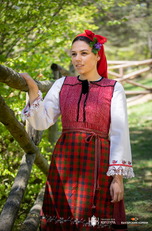Red „fustanela”, typical for the village of Banya from the 1920s
- Грозделина Георгиева-Саватинова

- Jul 5, 2021
- 3 min read
Updated: Nov 4, 2021
The feet are covered with knitted woolen socks with red on the toes and heels, which they put on to protect them from evil eyes and shod in comfortable for work moccasins from pigskin or calfskin. The head is veiled with a „shamiya” - a thin veil made of cotton or silk in red, tied above the head on one side. Often the ends of the „shamiya” are additionally turned. When there is no decoration with metal jewelry on a holiday, a mandatory decoration is a fresh wrist. Even in the field while working, the girl puts her wrist in water to decorate it fresh when she goes home and replaces the colored „shamiya” with a thin white one. In the photo, the girl is wearing a white shirt "koshulya" with decoration on the sleeves, with hand-knitted lace framing the sleeves and a short on the skirt. This is a summer red skirt, specific to Razlog. It is made of homemade woven red striped fabric (ie white stripes vertically on the fabric). It fastens at the front with wire buttons hidden under the fabric, wrapped everywhere with velvet strips. It repeats the dress pattern of the "white fustanela", widely used in the region after the 1920s. Highly fitted and stucked to the torso upper part and sewn to it a skirt pleated with basti, on which in the lower part are sewn additional strips of velvet, used for decoration. This dress, in addition to being comfortable, attracts attention to women's charms with every movement.

Belted with a "futen preskutnik" - a double apron of red and green plaid with winding embroidery of vine leaves in white. This is a favorite combination in the area for young brides and grooms. The waist, double-tied with „lashnitsi” (the long straps of the apron, woven without a hill with small rhombic ornaments) in this case also play the role of a belt in everyday clothing.

This transitional to urban style outerwear continues its connection with traditional clothing, with a shirt always placed underneath and an apron on top. This shows that she knows and takes measures to always be "protected" from obscene and bad thoughts and eyes. These are the two obligatory elements of women's clothing, which show that she is a decent member of society and follows the established rules.
The feet are covered with knitted woolen socks with red on the toes and heels, which they put on to protect them from evil eyes and shod in comfortable for work moccasins from pigskin or calfskin.
The head is veiled with a „shamiya” - a thin veil made of cotton or silk in red, tied above the head on one side. Often the ends of the „shamiya” are additionally turned. When there is no decoration with metal jewelry on a holiday, a mandatory decoration is a fresh wrist. Even in the field while working, the girl puts her wrist in water to decorate it fresh when she goes home and replaces the colored „shamiya” with a thin white one.


Latchezata Parmatova put on the costume.
The costume is of the genius from Razlog.
The project "Study of the specifics and richness of national costumes from the Razlog region in the light of cultural diversity" is realized with the financial support of the National Culture Fund under the program "Cultural Heritage".
In fulfillment of the goals of the project we present some of the most beautiful traditional costumes, typical for the Razlog valley in the last 2 centuries.
We offer our sincere thanks to our hosts from the Historical Museum - Razlog, and to all local people who helped with the realization.
Special thanks to all participants and team members who took their time and with useful information, knowledge and valuable advice made possible the work on the project.
A reverence to the girls and boys from the town of Razlog, who stood in front of our camera and with their enthusiasm, youth and beauty revived for a new life the most beautiful costumes from old Mehomiya.
























Comments